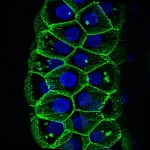(Press-News.org) Systematic review of 8 studies in more than 7,700 serodiscordant couples in 25 countries finds people living with HIV with viral loads less than 1,000 copies/mL have almost zero risk of transmitting the virus to their sexual partners. Previous studies have not been able to confirm a lack of transmission risk above 200 copies/mL.
Systematic review also consolidates and reinforces previous studies that have found there is zero risk of transmitting the virus to sexual partners when people living with HIV have an undetectable viral load.
Of the more than 320 documented sexual HIV transmissions in the study, only two involved a partner with a viral load of less than 1,000 copies/mL. In both cases, viral load testing was performed at least 50 days before transmission took place.
At least 80% of transmissions involved a partner with HIV who had a viral load greater than 10,000 copies/mL.
The findings are published alongside a new WHO policy brief providing updated guidance for HIV treatment monitoring and accompanying supportive messaging regarding transmission risks.
Together the new study and policy brief advance global efforts to achieve undetectable viral loads by expanding antiretroviral therapy (ART) for all people living with HIV and
reinforce the importance of decriminalising HIV and reducing stigma and discrimination for people living with HIV.
People living with HIV who maintain low – but still detectible – levels of the virus and adhere to their antiretroviral regimen have almost zero risk of transmitting it to their sexual partners, according to an analysis published in The Lancet. The study’s findings will be presented at an official satellite session ahead of the 12th International AIDS Society Conference on HIV Science (IAS 2023). [1]
Findings from the systematic review indicate the risk of sexual transmission of HIV is almost zero at viral loads of less than 1,000 copies of the virus per millilitre of blood—also commonly referred to as having a suppressed viral load. The systematic review also confirms that people living with HIV who have an undetectable viral load (not detected by the test used) have zero risk of transmitting HIV to their sexual partners.
A new policy brief from the World Health Organization (WHO), published alongside the research paper, provides updated sexual transmission prevention and viral load testing guidance to policymakers, public health professionals, and people living with HIV based on this analysis. This guidance aims to further prevent the transmission of HIV and ultimately support global efforts to achieve undetectable viral loads through antiretroviral therapy for all people living with HIV and to prevent onward transmission to their sexual partner(s) and children. [2]
Previous research has shown people living with HIV with viral loads below 200 copies/mL have zero risk of sexually transmitting the virus. However, until now, the risk of transmission at viral loads between 200 and 1000 copies/mL was less well defined.
The authors filled this knowledge gap by searching databases for all research studies published between January 2000 and November 2022 on sexual transmission of HIV at varying viral loads. In total, eight studies were included in the systematic review, providing data on 7,762 serodiscordant couples – in which one partner was living with HIV – across 25 countries.
Lead author Laura Broyles, MD, of the Global Health Impact Group (Atlanta, USA), said: “These findings are important as they indicate that it is extremely rare for people who maintain low levels of HIV to transmit it to their sexual partners. Crucially, this conclusion can promote the expansion of alternative viral load testing modalities that are more feasible in resource-limited settings. Improving access to routine viral load testing could ultimately help people with HIV live healthier lives and reduce transmission of the virus.” [3]
Taking daily medicine to treat HIV – antiretroviral therapy, or ART – lowers the amount of the virus in the body which preserves immune function and reduces morbidity and mortality associated with the virus and helps reduce HIV progression. Without ART, people living with HIV can have a viral load of 30,000 to more than 500,000 copies/mL, depending on the stage of infection. [4]
While using lab-based plasma sample methods provides the most sensitive viral load test results, such tests are not feasible in many parts of the world. However, the new findings support the greater use of simpler testing approaches, such as using dried blood spot samples, as they are effective at categorising viral loads for necessary clinical decision-making.
Of the 323 sexual transmissions of HIV detected across all eight studies, only two involved a partner with a viral load of less than 1000 copies/mL. In both cases, the viral load test was performed at least 50 days before transmission, suggesting individuals’ viral load may have risen in the period following the test. In studies that provided the full range of viral loads in partners with HIV, at least 80% of transmissions involved viral loads greater than 10,000 copies/mL.
Co-author Dr Lara Vojnov, of WHO, said: “The ultimate goal of antiretroviral therapy for people living with HIV is to maintain undetectable viral loads, which will improve their own health and prevent transmission to their sexual partners and children. But these new findings are also significant as they indicate that the risk of sexual transmission of HIV at low viral loads is almost zero. This provides a powerful opportunity to help destigmatise HIV, promote the benefits of adhering to antiretroviral therapy, and support people living with HIV.” [3]
The authors acknowledge some limitations to their study. Some of the data analysed were imprecise due to variations across the studies in the definitions of ‘low viral load’, and in the timing and frequency of viral load testing and patient follow-up. Today, HIV treatment is recommended for everyone living with HIV and very large sample sizes would be needed to develop more precise estimates given the extremely low number of transmissions.
Further, the findings do not apply to HIV transmission from mother to child, as the duration and intensity of exposure – during pregnancy, childbirth, and breastfeeding – is much higher. Differences also exist in the way the virus is passed from mother to child as compared with sexual transmission. Ensuring pregnant and breastfeeding women have undetectable viral loads throughout the entire exposure period is key to preventing new childhood HIV infections.
Writing in a linked Comment, co-authors Linda-Gail Bekker, Philip Smith, and Ntobeko A B Ntusi (who were not involved in the study) said, “Laura N Broyles and colleagues’ systematic review in The Lancet further supports the almost zero risk for sexual transmission of HIV at levels less than 1000 copies per mL…This evidence is relevant for at least three important reasons. First, it highlights the need for viral load testing scale-up in all settings where people are living with HIV and taking ART…Second, as pointed out by Broyles and colleagues, these data are probably the best that we will ever have. Standard of care now requires that individuals are offered life-saving ART regardless of viral load…Third, and most importantly, this study provides strong support for the global undetectable equals untransmittable (U=U) campaign. This campaign seeks to popularise the concept that individuals with undetectable viral loads are not infectious to sexual partners, thereby reducing stigma and improving quality of life.”
NOTES TO EDITORS
This study was funded by the Bill & Melinda Gates Foundation. It was conducted by researchers from the Global Health Impact Group and the World Health Organization.
[1] What's new in WHO guidelines: innovations, treatment, integration and monitoring: https://programme.ias2023.org/Programme/Session/4451
[2] The WHO policy brief will be available via the following link when the embargo lifts: https://apps.who.int/iris/handle/10665/360860. For embargoed access to the policy brief please contact mediainquiries@who.int
[3] Quote direct from author and cannot be found in the text of the Article.
[4] https://pubmed.ncbi.nlm.nih.gov/30401660/.
The labels have been added to this press release as part of a project run by the Academy of Medical Sciences seeking to improve the communication of evidence. For more information, please see: http://www.sciencemediacentre.org/wp-content/uploads/2018/01/AMS-press-release-labelling-system-GUIDANCE.pdf if you have any questions or feedback, please contact The Lancet press office pressoffice@lancet.com
END
The Lancet: People on ART with low but detectible levels of HIV viral load have almost zero risk of sexually transmitting the virus to others, in-depth review suggests
2023-07-23
ELSE PRESS RELEASES FROM THIS DATE:
Researchers identify genes that directly influence what we eat
2023-07-22
In one of the first large-scale studies of genes related to diet, researchers have uncovered almost 500 genes that appear to directly influence the foods we eat. The findings represent an important step toward using a person’s genetics to develop precision nutrition strategies that help improve health or prevent disease.
“Some genes we identified are related to sensory pathways — including those for taste, smell, and texture — and may also increase the reward response in the brain,” said research team leader Joanne Cole, PhD, assistant professor in the Department ...
Scientists name top five foods rich in prebiotics
2023-07-22
There is growing evidence that consuming prebiotics — certain types of fiber often found in plants that stimulate beneficial bacteria in your gut — can help to maintain a healthy gut microbiome. In a new study, scientists estimated the prebiotic content of thousands of food types by using preexisting literature to find out which foods offer the highest prebiotic content.
According to the study, foods that pack the greatest prebiotic punch are dandelion greens, Jerusalem artichokes, garlic, leeks, and onions. In addition to supporting gut microbes, prebiotic rich ...
A defense against attacks on unmanned ground and aerial vehicles
2023-07-22
A University of Texas at Arlington engineering researcher is working on defenses that could thwart cyberattacks against networks of self-driving cars and unmanned aerial vehicles.
Animesh Chakravarthy, associate professor in the Department of Mechanical and Aerospace Engineering (MAE), is the principal investigator on an approximately $800,000 U.S. Department of Defense grant titled “Resilient Multi-Vehicle Networks.” MAE Professor Kamesh Subbarao, and Bill Beksi, assistant professor ...
Renewable solar energy can help purify water, the environment
2023-07-22
Using electrochemistry to separate different particles within a solution (also known as electrochemical separation) is an energy-efficient strategy for environmental and water remediation: the process of purifying contaminated water. But while electrochemistry uses less energy than other, similar methods, the electric energy is largely derived from nonrenewable sources like fossil fuels.
Chemists at the University of Illinois Urbana-Champaign have demonstrated that water remediation can be powered in part — and ...
Fly toolkit created for investigating COVID-19 infection mechanisms
2023-07-21
Millions of deaths and ongoing illnesses caused by the COVID-19 pandemic have prompted scientists to seek new ways of understanding how viruses so skillfully enter and reprogram human cells. Urgent innovations leading to the development of new therapies are needed since virologists predict that future deadly viruses and pandemics may again emerge from the coronavirus family.
One approach to developing new treatments for such coronaviruses, including the SARS-CoV-2 virus that causes COVID-19, is to block the mechanisms by which the virus reprograms our cells and forces them to produce more viral particles. But studies have identified nearly 1,000 human proteins ...
Novel targets identified for treatment of schistosomiasis
2023-07-21
The worms that cause schistosomiasis (Schistosoma mansoni) are unusual in several ways, especially the fact that male and female adults must stay paired together throughout their lives for reproduction to be successful. Females may produce as many as 3,000 eggs per day. Approximately half reach the host’s gut or bladder. The rest are swept away via the blood to the liver and spleen, where they cause severe inflammation and liver cirrhosis, the main cause of mortality.
Researchers at Butantan Institute ...
Researchers illuminate resilience of U.S. food supply chains
2023-07-21
Researchers have identified a number of chokepoints in U.S. agricultural and food supply chains through a study that improves our understanding of agri-food supply chain security and may aid policies aimed at enhancing its resilience. The work is presented in a paper published in the July 20, 2023, issue of the journal Nature Food, “Structural chokepoints determine the resilience of agri-food supply chains in the United States,” by authors including CEE Associate Professor Megan Konar and CEE Ph.D. student Deniz Berfin Karakoc.
The agricultural and food ...
Spallation Neutron Source accelerator achieves world-record 1.7-megawatt power level to enable more scientific discoveries
2023-07-21
The Spallation Neutron Source at the Department of Energy's Oak Ridge National Laboratory set a world record when its particle accelerator beam operating power reached 1.7 megawatts, substantially improving on the facility’s original design capability.
The accelerator’s higher power provides more neutrons for researchers who use the facility to study and improve a wide range of materials for more efficient solar panels, longer–lasting batteries and stronger, lighter materials for transportation. The achievement marks a new operational milestone for ...
NIH awards will fund post-treatment Lyme disease syndrome research
2023-07-21
The National Institute of Allergy and Infectious Diseases (NIAID), part of the National Institutes of Health, has awarded five projects for research to better understand Post-treatment Lyme Disease Syndrome (PTLDS), which is a collection of symptoms, such as pain, fatigue, and difficulty thinking or “brain fog,” which linger following standard treatment for Lyme disease. The Centers for Disease Control and Prevention estimates that 476,000 people in the United States are infected with Lyme disease each year. Between 10 and 20% of ...
House Appropriations bill would slash life-saving medical research, disease prevention and treatment
2023-07-21
WASHINGTON—The Endocrine Society opposes severe funding cuts proposed in the House Labor, Health and Human Services, Education, and Related Agencies (Labor-HHS) funding bill that would put life-saving endocrine research, disease prevention, and treatment at risk.
The House Appropriations Committee is planning to mark up the Labor-HHS funding bill before Congress leaves for its August recess.
The proposed funding levels in the Labor-HHS bill would harm America’s public health infrastructure and restrict research investments needed to develop next-generation cures. Cutting funding will reduce or eliminate services ...




